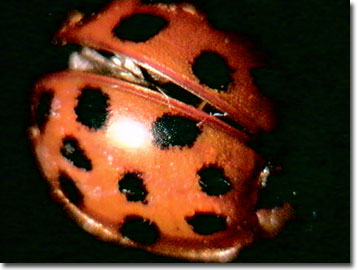Reflected Light Digital Image Gallery
Ladybug (Hippodamia species)
Known as ladybugs or ladybirds, members of the beetle family Coccinellidae in the genus Hippodamia are favorites of children and farmers. These black-spotted orange coleopterans are valuable as insectivores, which feed on plant pests found in gardens and crop fields.

View a second image of a ladybug (Hippodamia species).
There are nearly 5,000 different ladybug types in the world, with 400 known from North America. Included, is a recent arrival, Asiatic ladybug, (Harmonia axyridis), which is distinguished by its habit of swarming in houses during the winter and its unpleasant behavior of biting fingers and other exposed skin. These exotics can live from two to three years, and typically, for most species, as many as six generations of ladybugs hatch in a year. The larval stage is usually 21 days in length, followed by a pupal stage lasting one week. Eggs hatch typically in two to five days, but this depends upon the species and the environmental conditions (e.g., temperature, humidity).
A female ladybug may produce more than 1,000 eggs in her lifetime, the majority of these likely to be laid in an aphid colony. Since the highly destructive aphid is the favored diet of the beetle, ladybug eggs are available commercially to be used in integrated pest management, a practice that avoids the costs and environmental health risks of chlorinated hydrocarbon herbicides. The bright colors (black and orange) of the beneficial beetles are warning coloration to potential predators such as other insects and birds, alerting any that approach that this beetle tastes and smells terribly. Ladybugs produce a chemical that serves as a defense mechanism against insectivores, creating the odor and bitter taste.
The anatomy of the ladybug features wing covers or elytra, which serve as hard coverings for the beetle's fragile, transparent wings. The elytra are red, orange, or yellow and spotted with black dots, in most species. The spots do not usually develop for the first 24 hours of maturity, but once present, their patterns are used as keys by entomologists in differentiating species.
Ladybugs began to be featured as literary characters in traditional nursery rhymes and children's poetry during medieval times as a result of the practice in Europe of burning hops vines to clear the fields. The fires would result in the adult ladybugs flying away while the plant-bound larvae and pupae burned alive. After serious crop damage from aphids occurred during the Middle Ages in Europe, Catholic farmers praying to the Virgin Mary felt their relief was granted in the form of the aphid-eating beetles that they referred to as the "beetles of Our Lady", eventually shortened to "Lady Beetle". In Sweden, a ladybug landing on a maiden's hand was taken as an indication that marriage was imminent, while in France, if a ladybug landed on a sick person and flew off, it was thought that the beetle would take the illness with it. Early doctors even crushed ladybugs and applied the fluid to infected teeth to treat the pain. Perhaps, the terrible taste was able to distract the patient from the toothache.
Contributing Authors
Cynthia D. Kelly, Thomas J. Fellers and Michael W. Davidson - National High Magnetic Field Laboratory, 1800 East Paul Dirac Dr., The Florida State University, Tallahassee, Florida, 32310.
BACK TO THE REFLECTED LIGHT IMAGE GALLERY
BACK TO THE DIGITAL IMAGE GALLERIES
Questions or comments? Send us an email.
© 1995-2025 by Michael W. Davidson and The Florida State University. All Rights Reserved. No images, graphics, software, scripts, or applets may be reproduced or used in any manner without permission from the copyright holders. Use of this website means you agree to all of the Legal Terms and Conditions set forth by the owners.
This website is maintained by our
Graphics & Web Programming Team
in collaboration with Optical Microscopy at the
National High Magnetic Field Laboratory.
Last Modification Friday, Nov 13, 2015 at 01:19 PM
Access Count Since September 17, 2002: 16010
Visit the website of our partner in introductory microscopy education:
|
|
